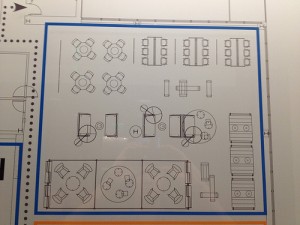
Starting with a well-researched office layout plan will ensure that your move or office reconfiguration will go smoothly.
If you have the lucky job of laying out a new office or reconfiguring an old one, there's a litany of things you'll want to keep in mind. Everything from available space to infrastructure to the type of work being completed should factor in to the layout and design.
To get you started, we've compiled 5 steps toward planning your office space layout.
What to Consider:
1. Culture: The type of business you run should dictate the design of the office. Whether you're a business whose employees need private space to meet with clients or a business that thrives on teamwork and collaboration or something in between, it's critical that the office be designed in a way that meets the needs of the work being done. Options include a more traditional space with closed-off offices for those who need more focused workspace, an open floor plan to encourage conversation and idea sharing, or a mix of both closed and open workspace. Beyond the type of workspace, culture should be reflected in the colors and type of furniture you pick. Keep in mind that color can have a dramatic affect on employees' mood and productivity, so don't just look at it as window (ahem, ?wall dressing).
2. Size of office: Of course, the physical size of your office space will affect how you plan your space. If you have a lot of employees and a smaller space, you'll need to find efficiencies in workspaces, conference rooms and support spaces (think break rooms, libraries or copy rooms). With more square footage, you'll want to keep in mind basic factors, like how many employees have access to natural light, acoustics and how easy the space is to navigate. The size of your office and the number of employees working in it will also be a factor in the size of the furniture you choose. Obviously, if you have 10 employees in a 100 square foot office, not everyone will be getting that enormous executive desk. You'll also need to factor in space for things like aisles and storage.
3. Projected growth: While it might be tempting to save money on real estate and workspace, it's wise to think longer term when you're laying out your office. Make plans based on how much you project your business will grow in the next year (or five years if you're feeling confident/ambitious). Create a layout plan and purchase furniture that can grow easily with your business rather then reconfiguring the whole office every time you hire a new employee.
4. Type of work being completed: Chances are your employees don't spend the day anchored to a chair in front of their computer. They probably meet with co-workers, take coffee breaks and visit a restroom from time to time, as well. Your office can't just be a room full of desks. There should also be space for formal and informal meetings, a break room and/or space to play (a foosball table is the perfect place for employees to recharge for a few minutes and kick around new ideas), designated areas for communal office equipment (copiers, etc.), and (especially if you have an open office) booths or cubicles designated for private phone calls. Also, different departments might have different space requirements. Customer service representatives might only need a small desk for a computer and phone while designers would potentially need more space to spread out. Accountants might appreciate a quiet workspace while marketing will thrive in an open area. Create a holistic plan that keeps all of these needs in mind.
5. Other considerations: As if you didn't have enough to think about, you'll also need to consult with your landlord to makes your plans are all to code and within the terms of your lease and make sure you're within federal accessibility laws. Then you need to make sure you've considered infrastructure to ensure that all of your workstations will have the appropriate access to power, phone lines and Internet. The last thing you want is extension cords tripping up all of your employees.
But before you start to break out in hives …
Relax. You don't have to create a plan on your own. After you've completed your office analysis as to the type of office space you want, how many employees you have and the size of the office, etc., enlist the help of a professional CAD designer. The good news for you is that?Arnolds has folks on staff who can help you with all of your office planning so you don't commit any major planning faux pas (not giving employees enough space, aisles that are too narrow, creating a cubicle maze, etc.). Of course, if you'd prefer to go the DIY route, we're happy to point you to some useful resources (like this article on 3 great options for office plan layout software.)





